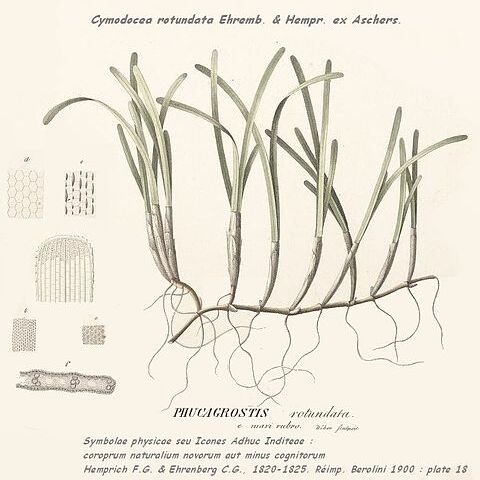Marine herb; rhizome delicate, each node with 1– 3 irregularly branched roots and erect stem to 6 cm long with 2– 7 leaves; internodes 1– 4.5 cm long; scales to 1 cm long.. Leaf with sheath pale purplish, slightly obconical, 1.5– 5.5 cm long, the auriculae 0.5– 1.5 mm long, acute, the ligule 0.5 mm long; old sheaths forming a scarious mass; scar closed; blade linear, often slightly falcate, 7– 15 cm long, 2– 4(– 5) mm wide, entire, rarely slightly spinulose, apex rounded, sometimes slightly emarginate; nerves 9– 15.. Staminate flower stalked; anthers 11 mm long.. Pistillate flower of very small ovary and short style, the stigmas > 3 cm long, spirally coiled.. Fruit 1– 2, sessile, semicircular and laterally compressed, to 10 mm long, 6 mm wide and 1.5 mm thick, with 3 dorsal parallel ridges, the middle one with conspicuous teeth, and with 1 ventral ridge with 3– 4 teeth, beak apical, persistent, 2 mm long.
Rhizome 2 mm diam., internodes 5–30 mm long, without cortical fibre bundles. Roots 1–3, branched. Stem with 2–7 leaves; leaf scar closed. Leaf sheath obconic, gradually cuneate at base, 15–50 mm long; old sheaths forming a scarious mass; ligule 0.5 mm high; auricles acute. Leaf blade linear to somewhat curved, usually falcate, 7–15 cm long, 2–4 mm wide; apex obtusely rounded, slightly serrulate; longitudinal veins 7–15. Male flower: anthers 10 mm long. Female flower: ovary small; style 5 mm long; stigmas at least 30 mm long, spirally coiled. Fruit 1 or 2, sessile, semicircular in outline, 10 mm long, 6 mm wide, 1.5 mm thick, with 3 distinct dorsal parallel ridges; median ridge with 6–8 conspicuous acute teeth; ventral ridge with 3 or 4 teeth; beak somewhat curved, 2 mm long.
Creeping rhizomes slender, each node with 1-3 roots and 1 short erect shoot. Leaves 2-5 together on shoots, ± falcate, 7-15 cm × ca. 4 mm, 9-15-veined, with secondary veins between lateral veins, sometimes slightly dentate toward apex, apex rounded to truncate; sheaths 1.4-4 cm. Anthers ca. 1.1 cm. Carpel ca. 5 mm along with slender styles. Fruitlet semicircular, ca. 1 cm, abaxially with 3 parallel ridges, middle ridge 6-8-toothed.


